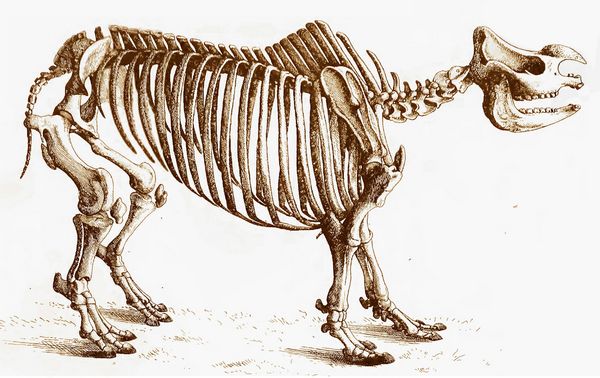Athena Review Image Archive ™
Rhinoceros skeleton drawn by Cuvier (1812)

Rhinoceros skeleton drawn by Cuvier (after Cuvier 1812, vol.3).
The French naturalist Georges Cuvier (1769 –1832) was a major figure in establishing the fields of comparative anatomy and paleontology through his work in comparing living animals with fossils. His work is considered the foundation of vertebrate paleontology, and he expanded Linnaean taxonomy by grouping classes into phyla and incorporating both fossils and living species into the classification.
This drawing of a Rhinoceros skeleton by Cuvier dates from his 1812 publication Recherches sur les ossemens fossiles de quadrupèdes (Researches into the fossil skeletons of quadrupeds). Cuvier's anatomical drawings represent new standards of scientific accuracy achieved in the early 19th century.
The name Rhinoceros means "horned nose," and is derived from rhino-,
"nose" and -keras, "horn". There are two extant species in Africa,
and three in southeast Asia. They are grouped in the order of
Perissodactyls, meaning "odd toed" ungulates. Extent genera include Ceratotherium (White rhinoceros), Diceros (Black rhinoceros), Dicerorhinus (Sumatran rhinoceros), and Rhinoceros
(Indian and Javan rhinoceros). Rhinocerotoids diverged from other
perissodactyls by the early Eocene (55-45 mya), when fossils of Hyrachyus eximus from North America show a small hornless ancestor which resembled a tapir or small horse.
Reference:
Cuvier, G. 1812. Recherches
sur les ossemens fossiles de quadrupèdes, où l'on rétablit les
caractères de plusieurs espèces d'animaux que les révolutions du globe
paroissent avoir détruites. (4 volumes). Paris.
Copyright © 1996-2020 Rust Family Foundation (All Rights Reserved).